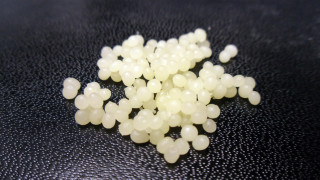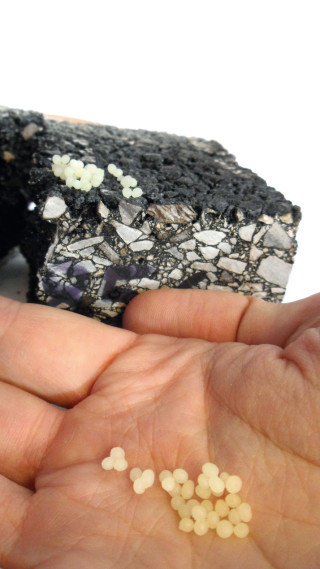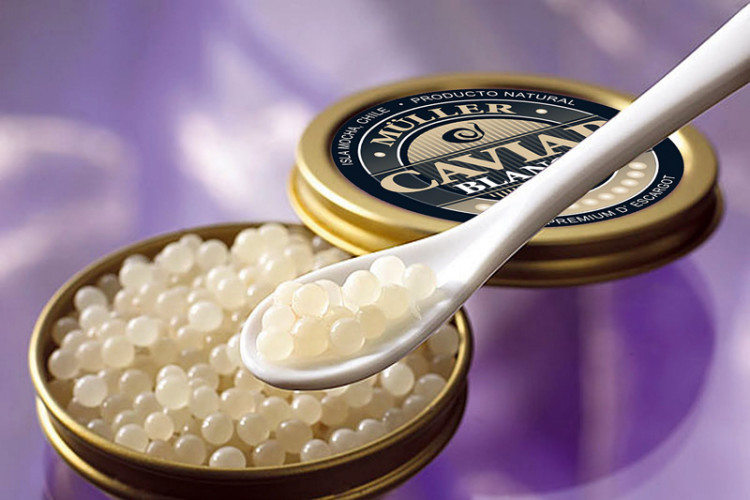On the face of it, haute cuisine doesn’t have much in common with asphalt mixes or road surfacing. But in one aspect at least, this is set to change, the element in common being something that closely resembles caviar – snail caviar, to be precise.
A lecturer at the University of Nottingham has come up with an innovative way of creating self-healing roads after being inspired by a technique he saw on the Spanish version of BBC Television’s MasterChef.
Dr Alvaro Garcia, who lecturers in the university’s Faculty of Engineering, realised that the ‘spherification’ technique used by one of the contestants to create artificial ‘caviar’ could provide just the breakthrough he was looking for in his work to develop roads that can recover from damage.
Spherification is the controlled ‘jellification’ of a liquid to form little spheres. While chefs typically make their caviar from exotic juices or even spirits, Garcia’s capsules contain something rather more mundane: sunflower oil. The result is a product that bears a striking resemblance to a naturally ‘spherified’ culinary novelty much prized in foodie circles: snail caviar.
The microcapsules of oil created by Garcia and his team can be incorporated into asphalt mixes to improve the self-healing abilities of roads. Sunflower oil can reverse the effects of ageing in the bitumen used to formulate asphalt by reducing the viscosity of the binder, explains Garcia.
Aggregates give structural stability to asphalt while the bitumen binds the aggregates together. But over the years, the bitumen in the road surface gradually oxidises and becomes friable, leading to ‘microcracking’ within the asphalt layer. Moisture can get in and reduce adhesion; traffic loads widen the microscopic cracks and accelerate the water penetration.
These microcracks may heal if bitumen can be encouraged to drain into them faster than the cracks are forming. This is where the oil comes in – it softens the surrounding bitumen so that it can flow more easily to fill the cracks. The oil is released when cracks cause the capsules to break open; it then helps accelerate self-healing so that the asphalt ‘sticks’ back together.
The microcapsules are activated in precise areas when required, thus avoiding the need to be mixed up in bulk.
Garcia, who is heading up the research, has named his pioneering ‘recipe’ Capheal. He says: “Our preliminary results showed that the capsules can resist the mixing and compaction processes without significantly reducing the physical and mechanical properties of asphalt and they also increased its durability. More importantly, we found that the cracked asphalt samples were restored to their full strength two days after the sunflower oil was released.”
The team, which is based at the Nottingham Transportation Engineering Centre (NTEC), estimates that Capheal could increase a road’s lifespan by at least a third from 12 to 16 years. And it only costs about the same as other additives that are commonly used in asphalt paving. Not surprisingly, Highways England has shown interest; it is funding the Nottingham research project.
Garcia feels that Capheal offers advantages over other self-healing technologies. “I previously worked on developing self-healing roads in the Netherlands and Switzerland that featured metal fibres,” he says. “An induction heater would pass over the surface to melt the bitumen and fill in cracks in the roads, but the problem with that is you need a large machine, which is expensive and requires a road to be closed to traffic.
“We needed a different way to create self-healing roads – without the use of an external aid – so I decided to design capsules containing oil that can break by themselves when the mechanical loading on a carriageway caused them to crack.”
Garcia’s interest in incorporating some form of capsules into self-healing roads dates back to 2010 when he was working at TU Delft in the Netherlands. He moved on to other areas of research before returning to the idea when he joined Nottingham University in late 2013. Here, two postgraduate students reproduced the experiments he had done at TU Delft with promising results.

Then one day, Garcia was watching Spanish TV when he saw someone using the spherification technique. “I bought the materials and tried it – and it worked,” he says. He couldn’t believe how good the results were or how simple the process was, though care is required to ensure the quantities and pH are just right.
Transport Focus research in 2015 showed that surface quality was road users’ top priority for improvement to England’s motorways and major ‘A’ roads, by some margin. But more information was needed on the particular aspects of concern and so Transport Focus and Highways England worked together to find out more. A newly published report, Road surface quality: what road users want from Highways England, shows that road users think surface defects on 70mph roads must in some way compromise safety.
Highways England is planning to carry out trials on sample sections of roads. Senior pavements advisor Robin Hudson-Griffiths says: “We know road users want good-quality road surfaces, with fewer potholes and not as many roadworks disrupting their journeys. This self-healing technology could give them that and offer real value for money.“
He adds: “So far the Nottingham University research we have funded is showing real potential in how easy it is to mix and apply, as well as being sustainable and environmentally friendly.”
Subject to the results of the trials, there is no restriction where this material could be installed on the network, says GHudson-Griffiths. Asphalt is used extensively throughout the network as a road surface or in lower pavement layers, and in time the self-healing asphalt could replace it.
.png)
“We have trialled the self-healing mixture in one of Tarmac’s asphalt mixing plants in Nottinghamshire and also in one of Roadmender’s trailer-mounted mobile batching systems,” he adds. “The capsules are manually added to a conventional hot-mix at the final stage of mixing; the binder easily coats and adheres to the capsules.”

The location of any on-road testing is yet to be confirmed, he says. Any initial testing would be on small patches of road; on carefully selected sections – that is to say, not a motorway, nor on the approach to a corner or roundabout.
“We would resurface small sections of road, during planned overnight maintenance work,” says Hudson-Griffiths. “We would expect any testing to happen during this financial year, although no date has been confirmed yet. We would need to monitor any patching work for approximately 12 to 24 months to confirm it is durable, to see how the material withstands the British weather and how it withstands heavy traffic flow, of a variety of vehicle types.”
Hudson-Griffiths expects that a second, on-road, testing project would be needed on a longer stretch of road. “This would depend on the outcomes of the initial testing, if the material is confirmed to perform as required, and if we can commission the work,” he says. This would involve identifying a scheme that is suitable, including factors such as geographical location and the ability to monitor it safely.
The spherification technique was first developed in the 1950s and was taken up by top chefs – and of course more recently by MasterChef contestants. The process used for Capheal begins with preparation of an emulsion by mixing sodium alginate and oil with water to create a very stable material.

The team then uses a dropper to take a quantity of the emulsion and add droplets of it to a calcium chloride solution. The sodium alginate binds with the calcium ions and forms an outer layer that encloses the inner liquid.
This calcium alginate shell forms capsules 2mm to 3mm in diameter. Inside each capsule there is a porous structure rather like a sponge, made up of smaller drops of oil in the alginate emulsion. Factors such as the concentrations of the chemicals and the time spent in the liquid affect the thickness of the outer layer.
The formation happens very quickly and at ambient temperatures, says Garcia. There is no need for lengthy curing or for altered temperatures or pH values, which avoids the need for any demanding health and safety protocols.
At present, the NTEC team is refining the geometry of the microcapsules to better understand how they degrade over time.
They will go on to develop capsules with varying degrees of strength to see how they perform under different types of stresses to determine their suitability for a range of asphalt mixes and traffic conditions.
Although the current capsules are performing very well, there remains scope for further advances. The capsules are currently 2mm to 3mm in size; Garcia would like to produce ones that are smaller. “The ideal size would be around 0.5mm I would say,” he adds.
There needs to be good contact between the aggregate particles in an asphalt mix in order to ensure sufficient strength. The capsules are very soft and large capsules would interfere with the aggregate matrix. The smaller they are, the less likely they are to compromise the asphalt strength - but if they are too small, they won’t rupture when required.
Although the university doesn’t have the resources for extensive physical exploration of new capsule designs, one way of maximising the design efficiency is to develop a computer model that will allow various properties to be tested before committing to a physical change.
Modelling will enable modifications to be carried out to determine which factors of the capsule would benefit from being changed in physical trials. Fast iterations will be possible, helping the team decide which potential alterations to concentrate on. “At the
moment we don’t really know which size and strength are optimum,” says Garcia. “We need a model to be able to know that in advance, before starting designing new capsules.”
So while Garcia and his team have yet to perfect their road-mending ‘snail’s eggs’, at least – with any luck – the development process won’t progress at a snail’s pace.
This article was first published in the December 2017 issue of The Construction Index magazine, which you can read for free at http://epublishing.theconstructionindex.co.uk/magazine/december2017/
UK readers can have their own copy of the magazine, in real paper, posted through their letterbox each month by taking out an annual subscription for just £50 a year. See www.theconstructionindex.co.uk/magazine for details.
Got a story? Email news@theconstructionindex.co.uk





